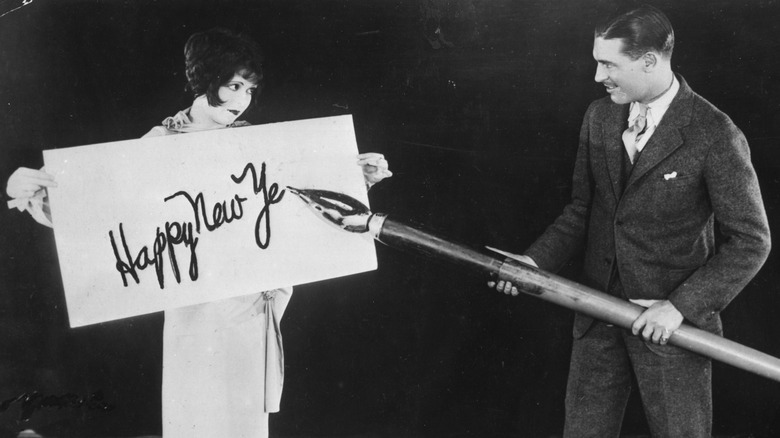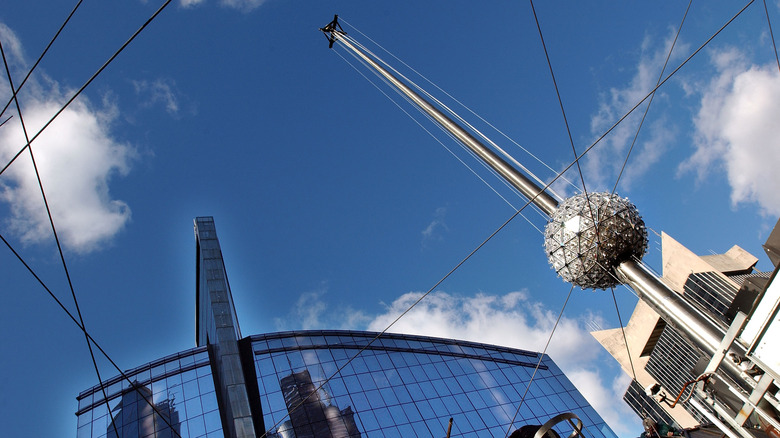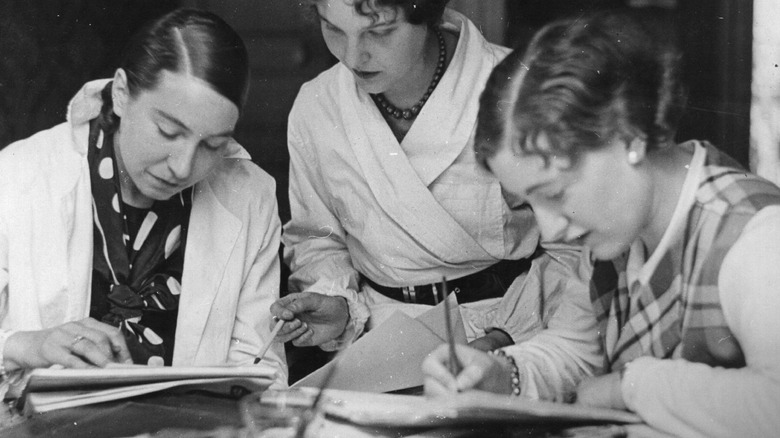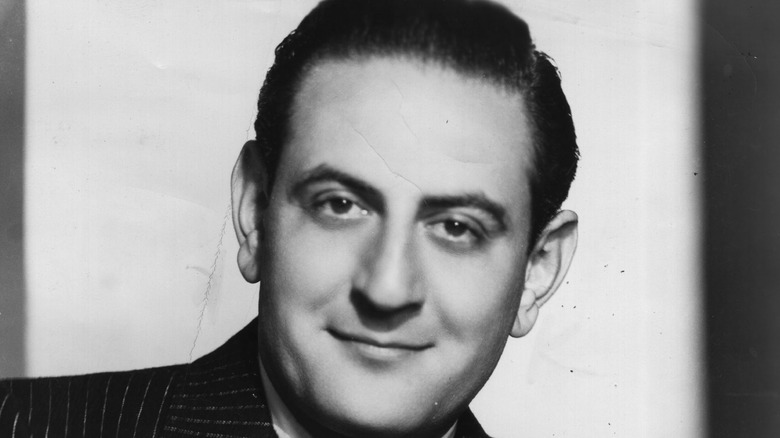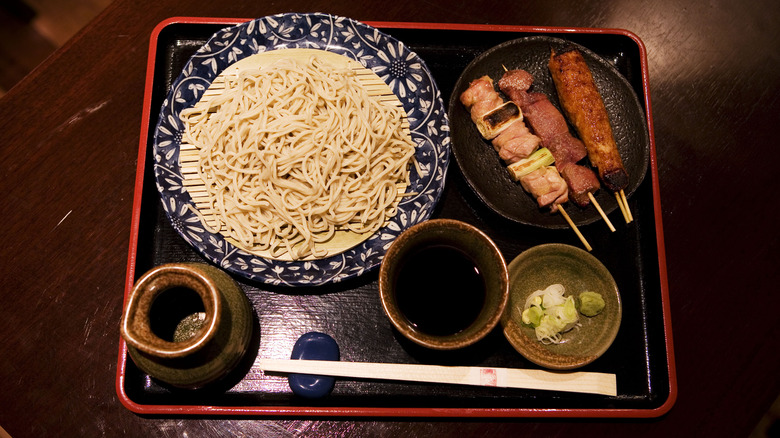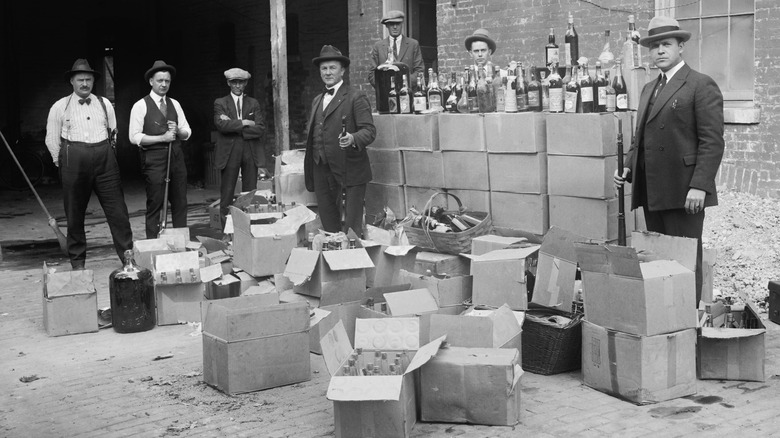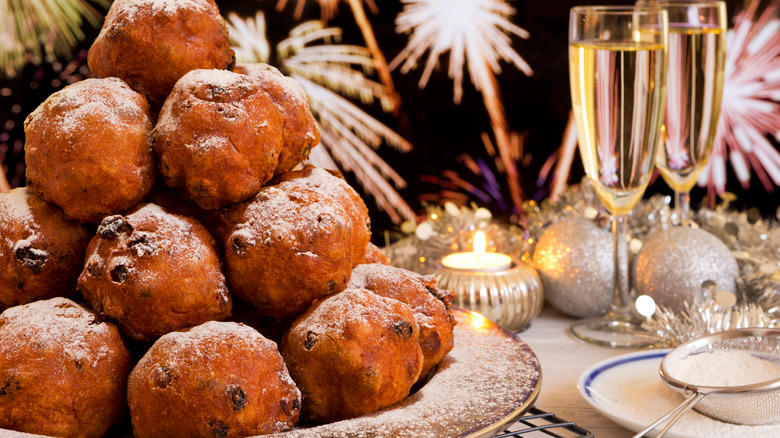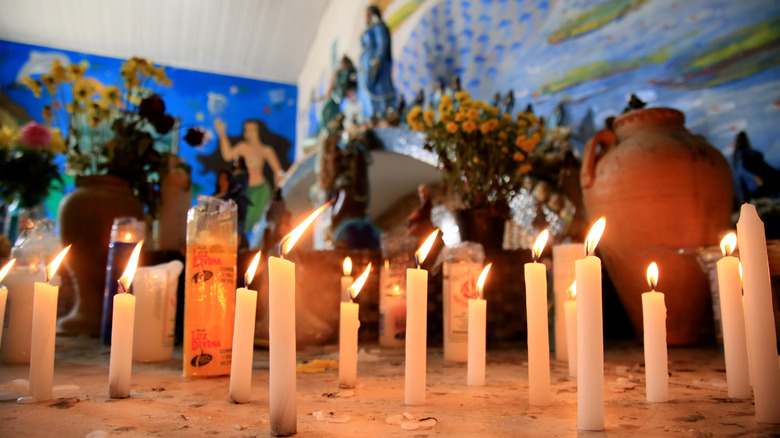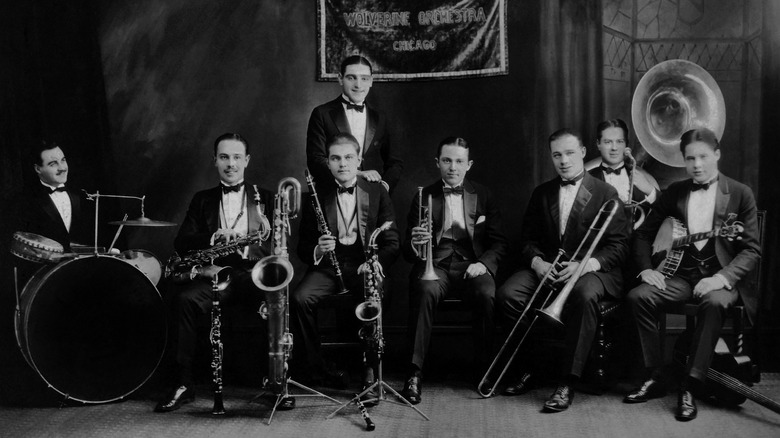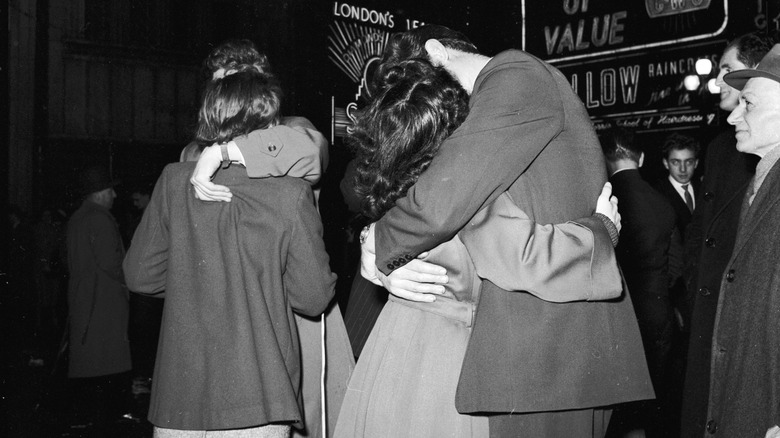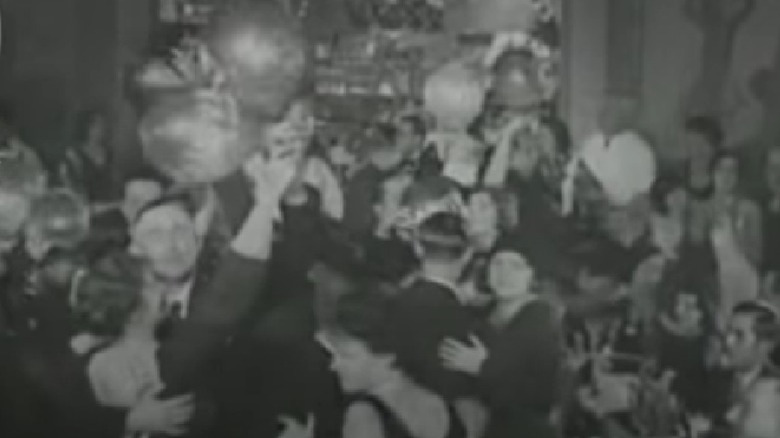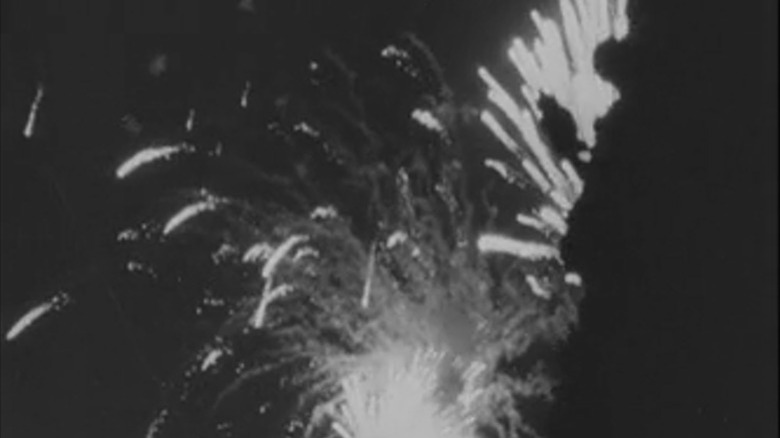What It Was Like To Celebrate New Year's Eve 100 Years Ago
Few holidays come with as much reflection and anticipation as New Year's Eve. Not only does this holiday get some of us in the mood to create resolutions, but it also makes us assess how far we've come (or still have to go) over the past year. Of course, 2020 and 2021 have proven incredibly challenging years because of the COVID-19 pandemic and its aftermath politically, socially, and economically. For some, this means bidding farewell to 2021 is more like saying good riddance, per The Guardian.
No matter how you feel about the recent past, most people can agree on the same thing: starting 2022 on the right foot. And this desire for a bright and optimistic future is nothing new. One hundred years ago, the world was in the midst of recovery after World War I and the Influenza Pandemic of 1918, according to History. Many people enjoyed a new sense of prosperity, and so when the holidays rolled around, they wanted to celebrate big.
Of course, this raises the question: What did New Year's celebrations look like a century ago? Here's what you need to know about how people partied around the globe and which traditions are still observed today.
Ball drops marked the occasion
Nothing says New Year's Eve like the Times Square Ball Drop in New York City, according to Time Square's official website. Crowds gather in the frigid streets for one of the biggest parties in the world. And people all over the globe tune in to watch this iconic farewell to one year and welcoming of another. Safe to say, it would be hard to imagine the passage of 365 days without this annual affair. Many people know very little about the rich history of the ball drop, however.
Timekeeping with a ball started at England's Royal Observatory at Greenwich in 1833 with the scarlet time ball located atop Flamsteed House (via Royal Museums Greenwich). Ships navigating the Thames used it to tell time, as did savvy London residents. By the mid-19th century, at least a dozen time balls existed at ports globally, per the New Yorker.
As for time balls as a source of end-of-the-year revelry, spectators began flocking to New York City's Times Square in 1904. But it would take three more years before the first ball got installed. Over the decades, seven versions of this time ball have helped celebrants countdown to January 1. A little more than one hundred years ago, in 1920, partiers would have watched a 400-pound wrought iron ball make the descent. This ball would serve its annual purpose until 1955, when an aluminum ball weighing 150 pounds replaced it.
New Year's resolutions set the tone
New Year's resolutions have been around for roughly 4,000 years, according to History. Dating back to the Babylonians, the first declarations were made directly to the gods, and so keeping them represented a sacred responsibility. For those who succeeded in sticking to their word, the Babylonians believed they would enjoy the favor of the divine for a year. (Not a shabby arrangement.)
New Year's resolutions have come a long way over the millennia. Yet, the essential desire to set goals continues to comprise an important part of New Year's festivities, and the same can be said for people living a century ago. People living 100 years ago sometimes published their objectives for the future in the dailies, providing us with a fascinating window into what interested them the most (via Newspapers).
Individuals in the early years of the 20th century focused on different things than many do today, like acting more cheerful and cussing less, as reported by The Atlantic. (Contrast this with today's obsessive focus on weight loss.) But they also debated the merits of New Year's resolutions just as today. One headline from the 1920s reads, "Has Making New Year's Resolution Gone Out of Style?" An answer from writer Fannie Hurst reads, "As a custom, New Year's resolutions making is charming. As a practice, at least for mere mortal of my kind of clay, it has about the pulling power of a flea."
'Auld Lang Syne' ruled the Atlantic airwaves
"Auld Lang Syne," a poem by the famed Scottish poet Robert Burns set to music, has long been a traditional New Year's song in Scotland. According to Time, it gained newfound fame across the Atlantic Ocean as performed by Guy Lombardo and his band on New Year's Eve as early as 1929. This radio performance lit up the airwaves, sparking a new tradition that the American populace could get behind. His concert was also the early 20th-century equivalent of Dick Clark's "New Year's Rockin' Eve" tradition.
Lombardo's annual rendition of "Auld Lang Syne" soon became a staple of annual television broadcasts as it remains to this day. Interestingly, geography inspired Lombardo to incorporate "Auld Lang Syne" into his first 1929 performance.
He and his band hailed from western Ontario, which boasted a large Scottish population. "Auld Lang Syne" originally crossed the ocean with these Scottish immigrants, becoming a song regularly heard at the end of dance sets. Although Americans generally reserve the song for the end of New Year's Eve dances, the influences from Scotland remain. In an interview with Time, Lombardo explained, "Auld Lang Syne is our theme song — and was long before anyone ever heard us on the radio."
Spanish locals ate 12 grapes apiece
In Spain, the last night of the year is known as Nochevieja and translates as "old night," according to National Public Radio (NPR). Since at least the 1880s, the Spanish have incorporated an eclectic tradition into their New Year's celebrations. At the ring of a dozen midnight bells, they pop 12 grapes into their mouths, attempting to chew and swallow them all before the last chime sounds.
Many believe the vine-growers of the nation's Alicante region launched the tradition to get people to eat more grapes. (Apparently, they had a particularly fantastic harvest in 1909 and needed a way to offload their precious produce without letting it go to waste.) Although the tradition has consumer roots, it quickly took off, ensuring plenty of grape noshing as people in the 1920s dove into bunches of grapes by the clock's chimes.
These 12 grapes came to be known as "las doces uvas de la suerte" or "the 12 lucky grapes." For those who chewed and swallowed them in time (with no mush left in their mouths), a year's worth of good fortune awaited. Today, all but 20% of these so-called "lucky grapes" originate in the Vinalopó Valley of central Alicante. A variety known as Aledo, the grapes have a light-green, fleshy appearance with a refreshing flavor. They provide the perfect, hangover-free punctuation to a new year.
The Japanese slurped soba noodles
One of Japan's oldest and most unique New Year's traditions is known as toshikoshi soba and involves slurping steaming bowls of buckwheat noodles, per Live Japan. Some believe the tradition has 800-year-old roots and began with a Buddhist temple that gifted the poor with soba noodles. Live Japan notes that the custom became widely practiced during the Edo Period, which was 1603 to 1867, via Britannica. So, presumably the Japanese were still devouring noodles well into the 1920s.
One of the most iconic soba noodle-making companies, Kanda Owariya, dates to 1923 and remains a family business (via Google Arts & Culture). Its current owner, Hideki Tanaka, is a third-generation owner. And he's both passionate and philosophical about the soba-making art. The establishment's primary product remains 2:8 soba, which will undoubtedly be slurped along with sake and side dishes this New Year's Eve.
In Japan, the beginning of the new year has long represented one of the most important holidays on the calendar, according to Savor Japan. In keeping with tradition, people still devour buckwheat noodles while watching celebrations taking place worldwide. Noodles may be served cold or warm with dipping sauces or in a broth like a soup. According to a recent survey, nearly 70% of people living in Japan share in this tradition.
One last (legal) hurrah before Prohibition
In America, people drank themselves silly during New Year's Eve festivities at the end of 1919, and many felt they had good reason for this. After all, Prohibition loomed with a start date of January 17, 1920, according to History. As one person put it, "With prohibition coming in and Emma Goldman going out, 'twill be a dull country," per the Gothamist. (Emma Goldman was a self-proclaimed anarchist deported to the Soviet Union for her extreme political views at the end of 1919, as reported by the Jewish Women's Archive.)
According to Gothamist, New Yorkers who saw Prohibition as a national disaster partied while they could, leaving a wake of hungover individuals on January 1, 1920. Of course, this wouldn't be the last hurrah for those willing to bend the rules and break the laws. But for law-abiding men and women, the future looked bleak.
New Year's Eve 1920 would go down as "agreeably dull," according to the New York Herald, as quoted in Bowery Boys History. The newspaper would lament, "A year ago the stuff could be toted around with perfect legality, and in the course of the revelry, thousands of bottles of it were given away to diners by restaurant men who took prohibition seriously and now curse their folly." That said, those unable to make do without inebriation found discreet ways to indulge, but these activities came with the real risk of law enforcement reprisals.
The Dutch feasted on oliebollen
Some New Year's traditions like New York City's Times Square ball drop are relatively new, but others have ancient roots. According to Paste Magazine, the Dutch have long feasted on oliebollen (literally "oily balls"), and a century ago proved no different. For those in the Netherlands, this meant savoring deep-fried, sugar-dusted confections, a traditional treat that stretches back to the 10th century and has some very dark roots.
In pre-Christian times, the Dutch ate oliebollen to defend against the cruelty of the pagan goddess Perchta. Tormented by an unquenchable hunger, she sliced her victims' stomachs open to get at the food inside. But eating oily foods such as oliebollen would ensure the sword slipped off the flesh without entering people's guts. Dutch immigrants to the United States first brought oliebollen to America, and over time it evolved into doughnuts, per Food52.
According to Logically, oliebollen witnessed a massive upgrade when a Jewish-American named Adolph Levitt invented the first doughnut-making machine in 1920 in the U.S. By 1934, doughnuts dominated the Chicago World's Fair as a symbol of progress and ingenuity. Levitt would found the Mayflower Doughnut line of shops and the Doughnut Corporation of America, raking in an impressive $25 million. As doughnut accessibility increased stateside, it appears associations with New Year's Eve decreased. Nevertheless, those of Dutch descent snacked on them (along with their cousins across the Atlantic) in the 1920s.
Saluting the goddess of the sea saw a boost
Brazilians place a unique spin on New Year's, per The Culture Trip, paying homage to the pagan Afro-Brazilian goddess of the sea, lemanja. According to the University of Texas at Austin, West Africans first arrived in Brazil as slaves in 1530. Among the traditions they brought to the New World would be the belief in Iemanja. Of course, they couldn't openly practice their religious beliefs, but enslaved Brazilians participated in clandestine rituals to the goddess for centuries.
With the abolition of slavery in 1888 (via National Public Radio), Brazilians of African descent could finally practice this New Year's tradition. Decades later, in 1925, Iemanja festivities got a massive publicity boost when a group of 25 Rio Vermelho fishermen made offerings to the goddess for calm seas and big catches. Since this initial event in 1925, the festival has exploded in popularity among all Brazilians. People from across the nation gather at the ocean to make offerings to the sea divinity between January 1 and February 2.
Traditionally, participants in Iemanja celebrations wear all white, and they offer various belongings to the deity. These include everything from flowers to mirrors. Locals also offer white foods like coconut puddings and sweet rice. Participants believe that if these offerings get washed into the ocean, Iemanja has accepted them in exchange for blessings.
Jazz helped ring in the New Year
If the 1920s had to be accompanied by a soundtrack, jazz would figure prominently, per the Public Broadcasting Service (PBS). After all, this decade is still known today as the "Jazz Age." This party music gained popularity throughout the decade, and the introduction of Prohibition ensured it would thrive in underground nightclubs fueled by organized crime and access to illegal booze.
According to Seton Hall University, one of the most popular jazz-playing speakeasies of the day was The Back Room in New York City. Located at 102 Norfolk Avenue, visitors to The Back Room today can still see how its original notorious guests accessed the joint, as reported by the establishment's official website. Multiple exits meant gangsters like Lucky Luciano, Meyer Lansky, and Bugsy Siegel could slip out as needed. So, they made it their favorite place to do business.
The Back Room was known as "The Back of Ratner's" in the 1920s, and it attracted a long list of movie and theater actors along with gangsters. As a result, the social scene proved hopping, especially during New Year's. For revelers willing to take a risk on illegal cocktails, such speakeasies would have been flowing with illegal alcohol and catchy music.
A midnight kiss ushered in a bright future
The tradition of midnight kisses on New Year's Eve can be traced back to ancient and medieval times through English and German folklore, according to Reader's Digest. Christina Fitzgerald, a professor at the University of Toledo, notes that one of the earliest mentions of a midnight kiss on December 31 came from the Arthurian legend "Sir Gawain and the Green Knight." (Basically, knights and ladies played a holiday game that required lip-smacking.)
Other historians believe the tradition goes back even further, pointing to ancient Rome's Saturnalia and the Viking's Hogmanay as likely precursors. Held on the winter solstice, Saturnalia represented one of the biggest holidays in the ancient world, and it involved plenty of public drunkenness (and presumably kissing). As for Hogmanay, a tradition still observed in Scotland, friends and strangers alike greeted one another on New Year's Eve with kisses.
Women's Health Magazine found one of the earliest references to the midnight kiss in a New York Times' publication from 1863 detailing German traditions. The article described how "as the last stroke dies into silence, all big and little, old and young, male and female push into each other's arms, and hearty kisses go round." The tradition would presumable get passed down through the generations (Women's Health also references the 1938 film "Holiday" as showing the first on-screen New Year's Eve kiss) and play a significant role in how people 100 years ago observed the passage from one year to the next.
Bubbly ushered in the New Year
Alcoholic beverages have long comprised an important part of festivities in Europe and the U.S., according to Imbibe Magazine. But when it comes to New Year's Eve, champagne has cornered the market. The evolution of champagne as the drink of choice on December 31 has a long and complicated history. But it's safe to say that the Industrial Revolution and the rise of the middle class had something to do with it.
In 1850, champagne sales sat around 6 million bottles per year. But by 1900, this figure skyrocketed to 28 million, with a good portion of the bubbly beverage dedicated to ringing in another year. By the early 1900s in New York City, many establishments had "champagne only" policies after 9 p.m. on New Year's Eve, as per Wine Bid, a practice often attributed first to Café Martin (a.k.a. Martin's), a high-end "lobster palace," (via Imbibe).
One person writing in 1910 noted, "To get a table at all on New Year's Eve is difficult. When you get one, you must drink what you are told," as quoted by Imbibe Magazine. That said, Prohibition put a damper on bubbly serving at legit establishments in the 1920s, which crippled New York's iconic lobster palaces, per historian Angela Tate's blog, Edwardian Promenade. Like other alcoholic beverages, champagne went underground in America in the 1920s. But it would have been freely savored in other parts of the world as a video of a New Year's party in Berlin, Germany, from the 1920s demonstrates (via YouTube).
Firecrackers and fireworks lit up Chinese New Year's displays
One of the most anticipated parts of New Year's Eve celebrations remains the launching of fireworks. These dramatic displays have existed for hundreds of years, with their origins stretching back into ancient Chinese culture.
According to China Highlights, pyrotechnics have long been a part of Chinese New Year's celebrations. Chinese New Year's falls between January 21 and February 20 on the lunar calendar (via China Highlights). These flashy festivities date back to at least the second century B.C., when the first natural firecrackers, bamboo stalks, would get tossed into fires to explode, as reported by American Pyro. Hollow air pockets within the bamboo fueled these explosions as they overheated.
Centuries later, gunpowder would pack a far more serious punch. But all the explosions shared something in common — the desire to ward off evil spirits and ensure a bright future in the new year. And this tradition would spread internationally, marking a vital part of festivities around the globe. One hundred years ago, people oohed and aahed as the skies lit up in places like Berlin (via Bridgeman Images). Today, New Year's firecrackers and fireworks are a part of celebrations globally, creating a festive ambiance from Asia to the Americas, Oceania to Iceland.
